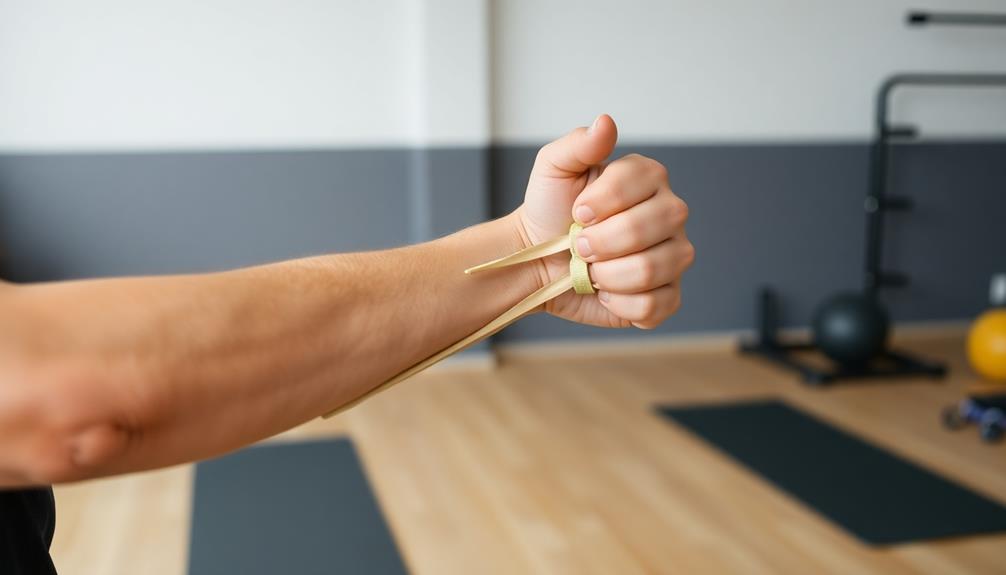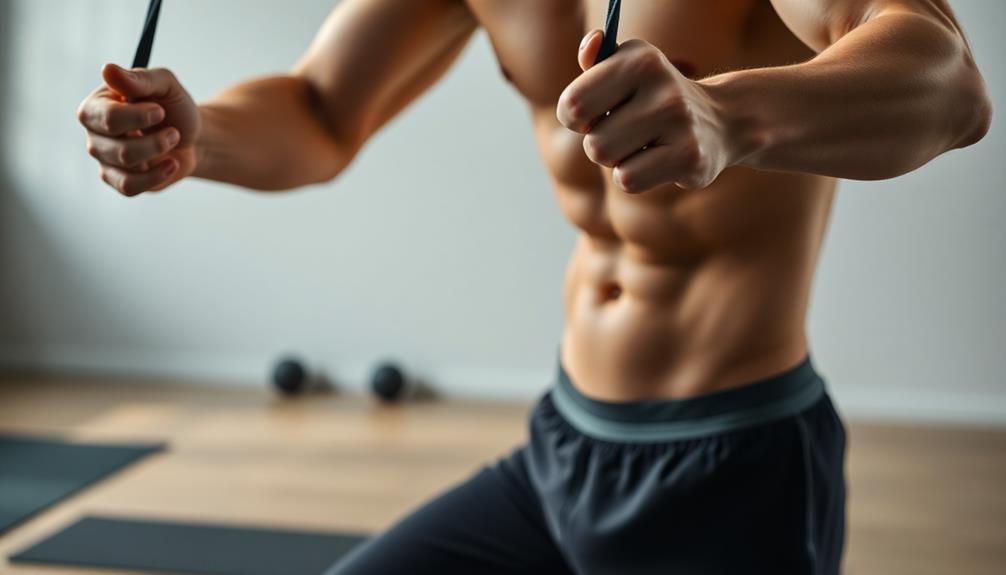Resistance stretching works by combining flexibility and strength training in a unique way. You'll tighten and lengthen your muscles simultaneously, using special tubes with varying resistance levels. This technique improves flexibility, strength, and muscle control. As you tighten muscles in a short position and then slowly lengthen them, you're engaging both muscles and connective tissue. This interaction enhances overall physical performance and activates proprioceptors for better coordination. The process also strengthens the brain-muscle connection, leading to improved athletic performance. By implementing resistance stretching techniques, you can prevent injuries, enhance muscle recovery, and build functional strength. There's more to discover about this effective training method.
Core Insight
- Resistance stretching combines muscle tightening and lengthening simultaneously, using special tubes with varying resistance levels.
- Muscles contract in a shortened position before slowly lengthening against resistance, improving flexibility and strength.
- The technique activates proprioceptors and enhances the brain-muscle connection, leading to better coordination and body awareness.
- It creates tension in connective tissue, making it more flexible while strengthening muscles through controlled resistance.
- Regular practice improves overall physical performance, prevents injuries, and enhances muscle recovery for various athletic activities.
The Basics of Resistance Stretching

Resistance stretching is a special type of stretching that mixes flexibility and strength training. It involves tightening and lengthening your muscles at the same time. This is different from regular stretching, where you just extend your muscles without using any force. You can use special tubes with different levels of resistance to make the stretching harder or easier, depending on what you need.
To do resistance stretching, start by tightening your muscle when it's in a short position. Then, slowly make the muscle longer while still keeping it tight. This makes the muscle work against resistance through the whole movement. You can use your own body weight, a partner, or equipment to create this resistance.
Resistance stretching can help you become more flexible, get stronger, and have better control of your muscles. It's really good for working on specific muscle groups and can help stop injuries from happening. But it's important to learn how to do it the right way before trying it on your own.
Muscles and Connective Tissue Interactions

Resistance stretching is a powerful tool for improving flexibility and overall physical performance. When you stretch against resistance, your muscles and the surrounding connective tissue, including fascia, tendons, and ligaments, work together. This interaction is key to getting the most out of your stretching routine.
As you stretch, your muscles contract and lengthen at the same time. This creates tension in the connective tissue, making it more flexible and pliable. The fascia, which is a thin, web-like tissue that wraps around your muscles, is especially important in this process. It adapts to the stretching force, allowing you to move more easily and with less stiffness.
Resistance stretching also activates sensory receptors called proprioceptors in your muscles and joints. These receptors help your body better understand its position and movement, leading to improved coordination and body awareness. Using mobility tools can enhance this process by targeting specific areas and helping you achieve greater flexibility.
Neurological Aspects of Resistance Stretching

Your nervous system is hard at work when you do resistance stretching. It's in charge of turning your muscles on and off, keeping them at the right tension, and helping you feel how your body is positioned. Your brain and spinal cord talk to your muscles, telling them when to tighten up or relax. This back-and-forth between your nerves and muscles is super important for getting the most out of your stretches and making your muscles stronger.
| Nerve Part | What It Does | How It Helps with Stretching |
|---|---|---|
| Motor neurons | Sends signals to muscles | Controls muscle tightening |
| Proprioceptors | Senses body position | Makes you more aware of your stretch |
| Golgi tendon organs | Detects muscle tension | Stops you from overstretching |
Resistance stretching isn't just about working your muscles; it's also about training your nervous system. This can make your brain better at controlling your muscles, help you become more flexible, and boost your overall performance. The more you do resistance stretching, the stronger the link between your mind and muscles will get. This leads to smoother movements and a lower chance of getting hurt.
Benefits for Athletic Performance

Athletes can benefit greatly from adding resistance stretching to their training. This technique improves flexibility, strength, and performance. By stretching while engaging muscles, you improve range of motion and build strength at the same time. Like using massage balls, resistance stretching targets specific muscles and releases tension.
Resistance stretching helps prevent injuries by making muscles more elastic and joints more stable. It also improves muscle recovery after tough workouts, reducing soreness and fatigue. This technique makes you more aware of your body, leading to better coordination and balance during sports.
You'll also see improvements in power and explosive movements, as resistance stretching builds functional strength through your full range of motion. It's especially helpful for sports needing quick direction changes or fast acceleration. By adding resistance stretching to your training, you give yourself an advantage in sports.
Implementing Resistance Stretching Techniques

Mastering resistance stretching takes time and practice. To start, pick a muscle group to focus on. Get into a comfortable position, then tighten the muscle while stretching it at the same time. You'll feel tension as you resist the stretch. Resistance levels can vary, so choose an intensity that matches your fitness level and goals. Beginners should use lower resistance for toning and rehab.
Hold the stretch for 10-30 seconds, then slowly release. As you get better, increase how long and intensely you stretch. It's important to keep good form during the whole exercise to get the most benefits and avoid injury.
Do resistance stretching 2-3 times a week, targeting the main muscle groups. You can use resistance bands or just your own body weight. Remember to breathe evenly and avoid bouncing or jerking. If you feel pain, ease off and talk to a professional for advice.
Comparison With Traditional Stretching Methods

Resistance stretching is different from traditional stretching methods you might be used to. Instead of holding a position to stretch your muscles, resistance stretching involves actively tightening and lengthening your muscles against force. This can help you become more flexible and make your muscles stronger. You'll use resistance tubes with different levels of resistance to create a workout that's just right for you.
Traditional stretching often focuses on lengthening your muscles without engaging them fully. Resistance stretching, on the other hand, works your muscles in both the tightening and lengthening phases. This can help reduce your risk of injury and make your muscles work better overall.
Resistance stretching takes more effort and focus than traditional methods. It's a tougher workout that can give you results faster. But it's important to use the right form and technique to avoid strain or injury. Always pay attention to how your body feels and take it slow when adding resistance stretching to your routine.
Frequently Asked Questions
Can Resistance Stretching Help With Chronic Pain Conditions?
Yes, resistance stretching can help with chronic pain conditions. It increases flexibility, strengthens muscles, and improves circulation. You'll likely experience reduced pain and improved mobility as you practice this technique consistently. Always consult your doctor before starting.
Are There Any Age Restrictions for Practicing Resistance Stretching?
You'll find no strict age restrictions for resistance stretching. It's suitable for most ages, but you should always consult your doctor first, especially if you're elderly or have health concerns. Start slowly and listen to your body.
How Often Should One Perform Resistance Stretching for Optimal Results?
You should perform resistance stretching 2-3 times per week for best results. Don't overdo it; give your muscles time to recover. Consistency is key, so stick to a regular schedule and gradually increase intensity as you progress.
Is Specialized Equipment Necessary for Resistance Stretching Exercises?
You don't need specialized equipment for resistance stretching. Your own body weight and muscles provide the resistance. However, you can use resistance bands or a partner to add variety and increase difficulty in your stretching routine.
Can Resistance Stretching Be Incorporated Into Rehabilitation Programs for Injuries?
Yes, you can incorporate resistance stretching into injury rehabilitation programs. It's effective for improving flexibility, strength, and range of motion. You'll need to work with a trained professional to guarantee proper technique and avoid aggravating your injury.

